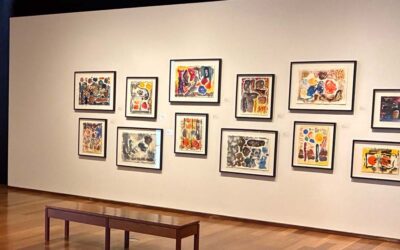Museum TrendsWatch 2023: The Metaverse, Web 3.0, and Climate Change

Rachael Cristine Woody
Each year the Center for the Future of Museums (under the auspices of the American Alliance of Museums) publishes a TrendsWatch report. Each year, I provide an analysis of the issues therein via a series of posts.
This year the report is titled TrendsWatch: Building the Post-Pandemic World and includes six trends: The Future Workplace, A Digital (R)evolution, The Partisan Divide, Repatriation, Restitution, Reparations; and the subjects of today’s post, The Metaverse and Web 3.0; and Changing Climate Risk. The first three trends are presented in the usual TrendsWatch format, but the last three are presented in a shorter, altered format. The Center offers no explanation for the change in format, and for our purposes we’ll combine both The Metaverse and Web 3.0 with Changing Climate Risk.
The Metaverse and Web 3.0
The Center introduces this section with: “A brief guide to terms that may be popping up in your newsfeeds.” This section provides definitions and little else on the metaverse or web 3.0.
Defining Metaverse: A blending of physical and virtual realities, from augmented reality (images, text, or sound layered onto the real world) to immersive virtual worlds.
Note: The picture accompanying this TrendsWatch article is from the Kremer Museum—a museum that only exists in the metaverse aka virtual reality. I profiled this museum in January 2019: To Be, or Not to Be: Virtual-Only Museums.
The metaverse is not a new thing. It’s been around since the early 2000s and has always been a part of the gaming community. It is currently receiving a lot of attention due to technology companies investing in this area—most notably Facebook (now Metaverse the company)—though this trend coverage didn’t age well as Facebook recently shuttered its billions of dollars attempt at creating a successful metaverse.
The Center ends this section with “[…] migration into the metaverse for work and leisure may speed up as better technology and platforms are rolled out.” But, given that we’ve had 20+ years with this technology available—and just endured a multi-year and life-altering pandemic that arguably should’ve made a virtual or augmented world even more appealing—I continue to be skeptical that a metaverse will ever be desirable to a majority segment of the population. And, if that is the case, then it seems ill-advised for museums to invest in providing a metaverse option when they’re still desperately trying to catch up on basic digital projects.
Defining Web 3.0: A decentralized internet, built on technologies like blockchain that allow storage and control of data to be distributed across severs owned by many individuals and organizations.
While not solely used for financial purposes, most of the focus these last few years has been on the economies created upon digital assets—cryptocurrencies and Non-Fungible Tokens (NFTs). While the Center doesn’t provide any further commentary on this term, we continue to see it influence the museum field. There are several areas of potential based upon web 3.0, such as NFT art, blockchain supported provenance, and the secure sharing an ownership of digital art and culture. The Center and myself explore the possibilities in more detail via Museum TrendsWatch 2019: Blockchain.
Changing Climate Risk
This section of the TrendsWatch report is labeled “Trend Alert” and only offers a brief summary on climate change with advice to museums. This section does little to add to the coverage previously offered in Museum TrendsWatch 2022: Emergency Response in the Face of Disaster.
Advice for Museums
The Center leaves us with the following advice for Changing Climate Risk:
- Monitor data and risk projections.
- Assess how heat and cold extremes can impact the museum (budget and operations) and the community.
- Evaluate if the museum needs upgrades to withstand more extreme weather events.
- Assess insurance coverage and work with insurance providers to receive the best coverage and mitigate risk.
- Explore how the museum can serve in local response to climate events.
- Provide public education on climate change.
Conclusion
This is such a curious conclusion to the TrendsWatch report. Hopefully the Center will ideate and spend more time on these trends over the coming months. Until then, a diving into their
TrendsWatch 2021 Strategic Foresight coverage as well as a toolkit (a $60 purchase) may be our best resources as we each attempt to foresee and plan for our immediate futures.

Rachael Cristine Woody
Rachael Woody advises on museum strategies, digital museums, collections management, and grant writing for a wide variety of clients. She has authored several titles published by Lucidea Press, including her newest, Prepare for Takeoff: Get Your Museum Digital Project off the Ground. Rachael is a regular contributor to the Think Clearly blog and an always-popular presenter.
Never miss another post. Subscribe today!
Similar Posts
From Preservation to Resilience: An Introduction to Building Resilient Digital Collections
Preserving a digital collection is a job that is never done. But what if we shifted our focus from preservation to building digital resilience?
Client Spotlight: MacLaren Art Centre Goes Beyond Collections Care to Access and Growth
“As our needs evolved, it became clear that our existing CMS was no longer working for us. Not only do we need to perform basic collections care, we need a system that will support public access, enable growth, and match our innovative strategies.”
Museum Collections Online: Digital Storytelling Blog Series Roundup
An overview of 10 blog post series that highlight how museums can leverage online collections and digital storytelling platforms, strategies, tools, and best practices.
How Museums Can Broaden Access and Improve Accessibility with Digital Storytelling
Museum expert Rachael Cristine Woody explains how digital storytelling expands access and improves accessibility of museum collections with inclusive multimedia formats.




Leave a Comment
Comments are reviewed and must adhere to our comments policy.
0 Comments